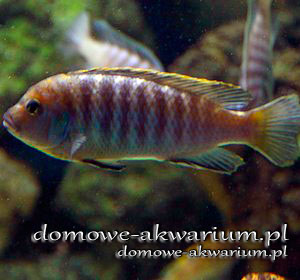
| Gatunek | Ornate Elongate Mbuna |
|---|---|
| Nazywany też | Elongatus Ornatus |
| Nazwa łacińska | Pseudotropheus Sp Elongatus Ornatus |
| Rodzina | cichlids |
| Występowanie | Afryka |
| Długość | 10 - 12 cm |
| Temperatura | 24 - 28°C |
| Twardość wody | medium hard - hard |
| pH | 7.5 - 8.5 |
| Zbiornik | 180 L |
| Pokarm | plant - świeży, dry, frozen |
Ornate Elongate Mbuna, Elongatus Ornatus
A freshwater species, endemic to Lake Malawi in Africa. It can be found there near the rocky coast of Likoma Island.
The coloration of males and females significantly differ from each other. The male is blue in color with dark, transverse bands running across the entire body. The female is light blue with yellow-orange areas - especially on the head, belly and around the base of the tail. She also has visible transverse, dark stripes - they are not as pronounced, though. Both males and females have dark edges on all fins. In males, they are much wider than in females. Additionally, the male is larger than the female.

Pseudotropheus sp elongatus ornatus is characterized by significant aggression towards its own species. Males fight with each other for dominance in the tank and for designated territories. We can recognize the dominant by bright colors. Submissive males tend to lose their coloration, which may resemble the coloration of females. This species belong to the Mbuna group and can be kept with other species from this group. The larger the number of fish, the greater peace in the aquarium. But remember to keep the tank size correspondingly large. This species feeds on algae.
The aquarium should be spacious, with free spaces for swimming and numerous hiding places among rocks, caves and crevices. Soft and fine substrate is also required, on which we should place a layer of coral sand, crushed freshwater shells or limestone rocks. This will naturally increase the pH in the aquarium. Plants are not required.
A species that lays eggs. Spawning is preceded by the male's courtship - with his "dance" he tries to encourage the female to reproduce in a previously prepared hiding place or a dug pit in the substrate. The female lays the eggs in batches, which she then gathers in her mouth. At this moment, the male slips his anal fin under her mouth. At the end of it, there are oval spots that resemble eggs in appearance. The female also tries to capture them in her mouth and at this moment fertilization occurs. The incubation of fry in the female's mouth lasts about 20-25 days. The fry grow quickly.